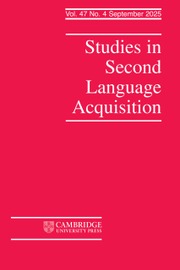Crossref Citations
This article has been cited by the following publications. This list is generated based on data provided by
Crossref.
Johnstone, Richard
2000.
Research on language teaching and learning: 1999.
Language Teaching,
Vol. 33,
Issue. 3,
p.
141.
TSUCHIYA, Satoshi
MISHIMA, Tetsuya
and
MAEKAWA, Koichi
2002.
SHEAR FAILURE AND NUMERICAL PERFORMANCE EVALUATION OF RC BEAM MEMBERS WITH HIGH STRENGTH MATERIALS.
Doboku Gakkai Ronbunshu,
Vol. 2002,
Issue. 697,
p.
65.
Nassaji, Hossein
2004.
The Relationship between Depth of Vocabulary Knowledge and L2 Learners' Lexical Inferencing Strategy Use and Success.
The Canadian Modern Language Review,
Vol. 61,
Issue. 1,
p.
107.
Barcroft, Joe
2004.
Second Language Vocabulary Acquisition: A Lexical Input Processing Approach.
Foreign Language Annals,
Vol. 37,
Issue. 2,
p.
200.
Rémon, Joséphine
2006.
Le cours de TIC : espace d’apprentissage linguistique ?.
Recherches en didactique des langues et des cultures,
NASSAJI, HOSSEIN
2006.
The Relationship Between Depth of Vocabulary Knowledge and L2 Learners’ Lexical Inferencing Strategy Use and Success.
The Modern Language Journal,
Vol. 90,
Issue. 3,
p.
387.
Mesa, Raquel Esquiliche
Bruton, Anthony
and
Ridgway, Tony
2007.
The Effect of Task-Based Reading on Fl Vocabulary Learning.
ITL - International Journal of Applied Linguistics,
Vol. 153,
Issue. ,
p.
1.
Bruton, Anthony
2007.
Partial Lexical Knowledge in Tests of Incidental Vocabulary Learning from L2 Reading.
The Canadian Modern Language Review,
Vol. 64,
Issue. 1,
p.
163.
Hellermann, John
and
Vergun, Andrea
2007.
Language which is not taught: The discourse marker use of beginning adult learners of English.
Journal of Pragmatics,
Vol. 39,
Issue. 1,
p.
157.
Akbulut, Yavuz
2007.
Effects of multimedia annotations on incidental vocabulary learning and reading comprehension of advanced learners of english as a foreign language.
Instructional Science,
Vol. 35,
Issue. 6,
p.
499.
BULTÉ, BRAM
HOUSEN, ALEX
PIERRARD, MICHEL
and
VAN DAELE, SISKA
2008.
Investigating lexical proficiency development over time – the case of Dutch-speaking learners of French in Brussels.
Journal of French Language Studies,
Vol. 18,
Issue. 3,
p.
277.
BARCROFT, JOE
2009.
Effects of Synonym Generation on Incidental and Intentional L2 Vocabulary Learning During Reading.
TESOL Quarterly,
Vol. 43,
Issue. 1,
p.
79.
SOGABE, Naoki
KITSUGI, Katsuhiko
IBUKI, Kazuyuki
MORIYAMA, Yoichi
ISHIYAMA, Kazuyuki
YAMANOBE, Shinichi
SUDA, Kumiko
and
WATANABE, Yoshimitsu
2011.
EXPERIMENTAL STUDY ABOUT THE APPLICATIONS OF REINFORCED CONCRETE BRIDGE PIERS WITH HIGH-STRENGTH-STEEL LONGITUDINAL AND HOOP REINFORCEMENT.
Journal of Japan Society of Civil Engineers, Ser. E2 (Materials and Concrete Structures),
Vol. 67,
Issue. 1,
p.
131.
Deschambault, Ryan
2012.
Thinking‐Aloud as Talking‐in‐Interaction: Reinterpreting How L2 Lexical Inferencing Gets Done.
Language Learning,
Vol. 62,
Issue. 1,
p.
266.
Eckerth, Johannes
and
Tavakoli, Parveneh
2012.
The effects of word exposure frequency and elaboration of word processing on incidental L2 vocabulary acquisition through reading.
Language Teaching Research,
Vol. 16,
Issue. 2,
p.
227.
Rassaei, Ehsan
2012.
The effects of synonym generation and oral output on incidental and intentional vocabulary learning.
ITL - International Journal of Applied Linguistics,
Vol. 164,
Issue. ,
p.
1.
Pietilä, Päivi
and
Merikivi, Riika
2014.
The Impact of Free-time Reading on Foreign Language Vocabulary Development.
Journal of Language Teaching and Research,
Vol. 5,
Issue. 1,
Türk, Emine
and
Erçetin, Gülcan
2014.
Effects of interactive versus simultaneous display of multimedia glosses on L2 reading comprehension and incidental vocabulary learning.
Computer Assisted Language Learning,
Vol. 27,
Issue. 1,
p.
1.
2015.
Lexical Input Processing and Vocabulary Learning.
Vol. 43,
Issue. ,
Davoudi, Mohammad
Zolfagharkhani, Moslem
and
Rezaei, Mojtaba
2016.
The Relationship between EFL Learners’ Extensive Reading and English Language Proficiency.
Theory and Practice in Language Studies,
Vol. 6,
Issue. 3,
p.
549.

